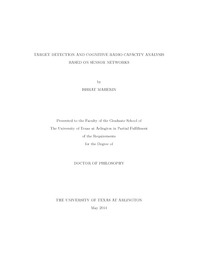
ATTENTION: The works hosted here are being migrated to a new repository that will consolidate resources, improve discoverability, and better show UTA's research impact on the global community. We will update authors as the migration progresses. Please see MavMatrix for more information.
Show simple item record
| dc.contributor.author | Maherin, Ishrat | en_US |
| dc.date.accessioned | 2014-07-14T20:21:31Z | |
| dc.date.available | 2014-07-14T20:21:31Z | |
| dc.date.issued | 2014-07-14 | |
| dc.date.submitted | January 2014 | en_US |
| dc.identifier.other | DISS-12595 | en_US |
| dc.identifier.uri | http://hdl.handle.net/10106/24395 | |
| dc.description.abstract | In this dissertation we studied two topics which are focused on target detection through foliage and capacity analysis of cognitive radio. We propose a multi-step information theory based scheme for target detection through foliage, using ultra wide-band (UWB) radar sensor network (RSN). This method is motivated by the fact that echoes from the stationary target, obscured by foliage, are more random than the region without the target. This is resolved by three steps of information fusion. Information fusion and integration is the process of combining data from several radar sensors and can achieve results that are not possible by individual radar operating independently. For first step of information fusion, we propose to use Kullback-Leibler (K-L) divergence based weighting. By using the information theoretic criterion known as method of types, we proved that false alarm can be inversely proportional to the relative entropy or KL distance. In the second step, we propose to use Maximum Entropy Method (MEM) and mutual information based detection. Finally, we use Dempster and Shafer (D-S) theory of evidence for decision. We further investigated and applied another information theoretic criterion known as Chernoff information to select the best radar sensor. We modified the algorithm we developed for RSN for single radar case and applied for human detection through wall. We successfully detected human behind a gypsum wall using single UWB radar. This proved that our method is not adhoc and applicable to various scenarios.Cognitive radio is an intelligent wireless device that can exploit the side information and maximize the spectral utilization. Efficient spectrum sensing along with transmit power control can achieve the conflicting goal of increasing the capacity while keeping the interference under limit. In this dissertation, we propose a sensor network aided cognitive radio system which will reduce the missed detection and reduce the interference. The non-convex optimization problem is divided in two separate sub problems and solved to get a suboptimal solution. Mathematical analysis shows that interference between primary and secondary depends on spectral distance, when the parallel channels are orthogonal like an OFDM based system. | en_US |
| dc.description.sponsorship | Liang, Qilian | en_US |
| dc.language.iso | en | en_US |
| dc.publisher | Electrical Engineering | en_US |
| dc.title | Target Detection And Cognitive Radio Capacity Analysis Based On Sensor Networks | en_US |
| dc.type | Ph.D. | en_US |
| dc.contributor.committeeChair | Liang, Qilian | en_US |
| dc.degree.department | Electrical Engineering | en_US |
| dc.degree.discipline | Electrical Engineering | en_US |
| dc.degree.grantor | University of Texas at Arlington | en_US |
| dc.degree.level | doctoral | en_US |
| dc.degree.name | Ph.D. | en_US |
Files in this item
- Name:
- Maherin_uta_2502D_12595.pdf
- Size:
- 1.710Mb
- Format:
- PDF
This item appears in the following Collection(s)
Show simple item record


